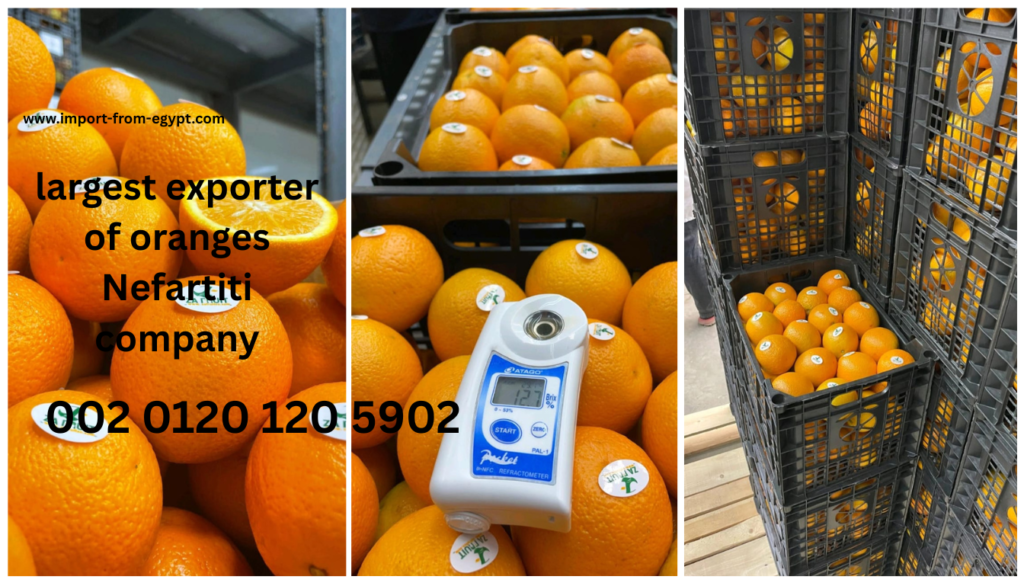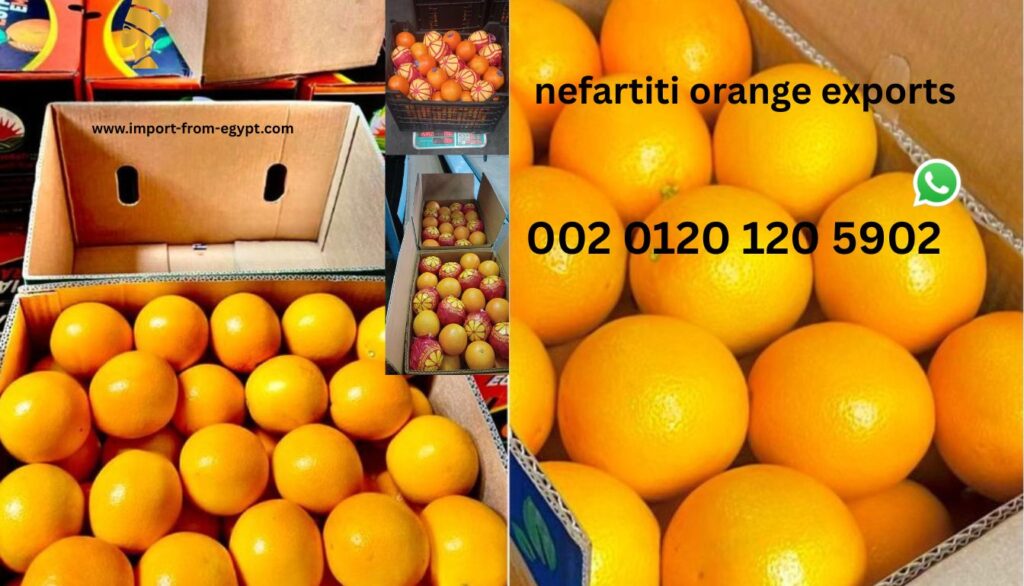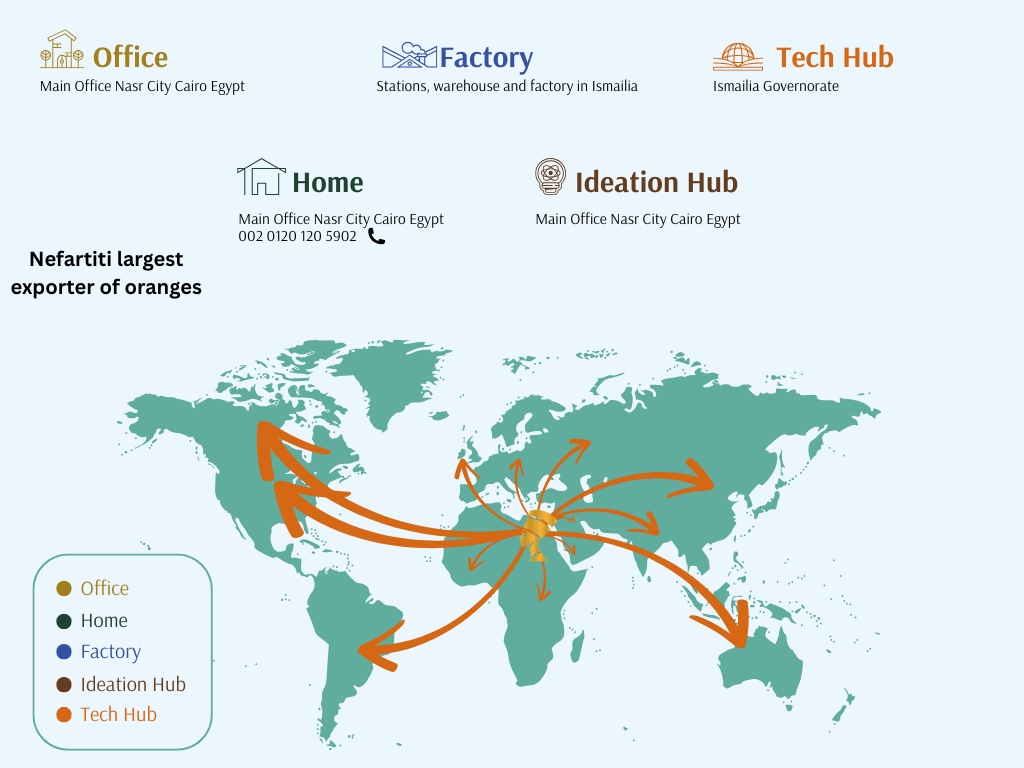- 00201201205902
- info@import-from-egypt.com
- 34, EL HEGAZ ST, CAIRO
Nefertiti Company, based in Egypt, is the world’s largest exporter of oranges. They are known for their premium quality Navel and Valencia oranges, achieved through advanced, sustainable agricultural practices like precision farming, efficient soil management, and integrated pest control. Nefertiti plays a significant role in the global orange trade, utilizing a robust distribution network and technology to overcome challenges like market fluctuations and climate change, all while prioritizing customer satisfaction and environmental responsibility.
Nefartiti: World’s Largest Orange Exporter
Nefertiti Company has firmly established itself as the largest exporter of oranges worldwide, setting a benchmark in the citrus industry. Recognized as a global orange supplier, Nefartiti is renowned for its premium orange exporter status, delivering top quality citrus products to markets around the globe. This article explores the expansive operations of Nefartiti, emphasizing its crucial role as a citrus industry leader and its significant contributions to the global orange trade.

largest exporter of oranges Nefartiti company
Key Takeaways
- Nefartiti is the largest exporter of oranges in the world.
- The company is recognized as a premium orange exporter globally.
- Nefartiti plays a significant role in the global orange trade.
- The company exemplifies leadership in the citrus industry.
- Its operations highlight commitment to quality and sustainability.
Introduction to Nefertiti Company
Nefertiti Company stands out as a pivotal player in the citrus industry, particularly recognized for its extensive nefertiti orange exports. Located in Egypt, this enterprise is often hailed as the best orange exporter due to its unwavering commitment to quality and innovation. As a premier global orange exporter, Nefartiti prides itself on its advanced agricultural methods and meticulous attention to detail, leading to the delivery of superior fruit.
The nefertiti fruit export company has established a robust distribution network that effectively serves various international markets. This strategic approach not only enhances its global reach but also solidifies its reputation among consumers and businesses alike. By focusing on excellence in every aspect of production and distribution, Nefartiti reinforces its status as a leader in the industry.

History of Orange Exporting in Egypt
Egypt boasts a long and rich history of orange exporting, characterized by an advantageous climate and fertile soil that contributes to the production of high-quality egypt oranges. This agricultural backdrop has enabled Egypt to be the world’s largest producer and exporter of oranges, cementing its place as a key player in the global citrus market.
The history of orange exports in Egypt dates back to ancient times when citrus fruits were cherished for their flavor and health benefits. Over the centuries, advancements in agricultural practices have facilitated the growth of orange cultivation. These techniques include improved irrigation methods and selective breeding, which have enhanced both the quality and quantity of the fruits produced.
As demand for Egyptian oranges grew internationally, the Egyptian government and local farmers began emphasizing the importance of phytosanitary measures to ensure the safety and quality of their products. Citrus pest management has become crucial in protecting orange crops from disease and pests, directly affecting the ability to compete in global markets.
Through a blend of historical significance and modern farming techniques, Egypt remains at the forefront of the orange export industry, providing a steady supply of this beloved fruit to markets worldwide.

history of orange exports in Egypt
Understanding Nefartiti’s Global Impact
Nefartiti plays a crucial role in shaping the international orange trade. As one of the leading orange trade companies, it has significantly influenced global markets with its top-tier citrus exports. The emphasis on quality farming practices enhances Nefartiti’s position as the best orange supplier in the industry.
The company’s commitment to sustainable agriculture and innovative logistics reflects a proactive approach that resonates beyond mere commerce. Nefartiti’s global influence extends to enhancing agricultural best practices, benefiting both local farmers and international partners. By establishing robust distribution channels, it ensures that quality oranges reach every corner of the world efficiently.
This combination of excellence and sustainability not only bolsters Egypt’s reputation as a top exporter but also facilitates economic growth within local communities, showcasing the intertwined nature of agriculture and global trade.
Largest Exporter of Oranges Nefertiti Company
Nefartiti stands as the largest exporter of oranges within the global market. With a commanding market share, the company consistently reports impressive orange export statistics, reflecting its strong nefertiti market position. Comprehensive analysis reveals that Nefartiti’s export volume not only meets domestic demands but also significantly contributes to international markets.
Market Share and Statistics
The prevalence of Nefartiti in the orange exporting arena is evident through detailed market share and statistics. Current figures indicate that Nefartiti dominates numerous key markets, with a notable share in North America and Europe. The company’s strategic distribution channels and robust supply chain management enhance its ability to respond effectively to market needs.

Comparison with Other Global Exporters
When assessing Nefartiti’s performance against other leading orange exporters like Spain and the United States, its operational efficiencies become apparent. Nefartiti offers competitive pricing while maintaining a focus on quality differentiation. This approach enables the company to retain a favorable position within global citrus statistics, showcasing how effectively it adapts to market dynamics.
Types of Oranges Exported by Nefartiti
Nefartiti stands out as a premium orange producer, offering a diverse range of orange varieties. Among the types of oranges exported by Nefartiti, Navel and Valencia oranges hold significant popularity in both domestic and international markets. Understanding these varieties provides insight into the high demand for nefertiti oranges among consumers worldwide.
Navel Oranges: A Popular Choice
Navel oranges are renowned as a best-selling orange variety due to their remarkable sweetness and convenient seedless nature. These attributes contribute substantially to their popularity among families and health-conscious individuals. The high demand for Navel oranges reflects their exceptional flavor profile, making them perfect for fresh eating and salads. Nefartiti ensures that their Navel oranges adhere to the highest standards, making them a cherished choice for shoppers across various markets.
Valencia Oranges: Quality and Demand
Valencia oranges are another integral part of Nefartiti’s export portfolio. These oranges are famed for their juiciness and vibrant flavor, which makes them ideal for juicing. The demand for Valencia oranges remains robust due to their versatility. Many consumers seek them not only for direct consumption but also as a key ingredient in the beverage industry. Nefartiti produces high quality Valencia oranges, cementing its position as a competitive player in the global citrus market.
Nefartiti’s Agricultural Practices
Nefartiti plays a significant role in the realm of orange cultivation through its innovative and effective agricultural practices. These nefertiti agricultural practices not only focus on producing high-quality oranges but also prioritize sustainable farming methods to ensure environmental health.
To enhance crop yield and minimize resource use, Nefartiti employs precision farming techniques. This approach allows for accurate monitoring of soil conditions, moisture levels, and nutrient availability, leading to tailored interventions that promote optimal growth. Soil management practices are crucial; they involve crop rotation, cover cropping, and the use of organic fertilizers, which enhance soil fertility while reducing dependency on chemical inputs.
Pest control is another vital aspect of Nefartiti’s agricultural strategies. The company utilizes integrated pest management techniques that combine biological control, cultural practices, and careful pesticide application. Such methods diminish the ecological footprint of orange cultivation, ultimately contributing to the sustainability of the farming system.
The following table highlights key features of Nefartiti’s sustainable farming practices:
Practice | Description | Benefits |
Precision Farming | Utilization of technology to monitor and manage the crop conditions accurately. | Increases yield and reduces waste of resources. |
Soil Management | Incorporating practices like crop rotation and organic fertilizers. | Enhances soil health and fertility. |
Pest Control | Integrated pest management combining biological and cultural methods. | Minimizes environmental impact while effectively managing pests. |
By embracing such advanced methods, Nefartiti not only champions the production of high-quality oranges but also sets a benchmark for sustainable farming in the agricultural industry. The commitment to environmentally friendly practices positions Nefartiti as a leader in responsible orange cultivation, ensuring that future generations can enjoy the benefits of rich and fruitful agriculture.
Commitment to Quality and Sustainability
Nefartiti embodies a strong commitment to quality while integrating sustainable practices across its operations. The company’s dedication to excellence in orange production is evident through the meticulous approach employed at every stage of cultivation and harvesting.
High-Quality Citrus Production Techniques
The focus on high-quality citrus production techniques begins with careful monitoring of growth conditions. This ongoing assessment allows for precise adjustments in irrigation, soil management, and pest control, ultimately enhancing the quality control processes. Nefartiti’s adherence to international quality standards ensures that each orange meets consumer expectations, which reinforces its position as a leader in the industry. Best practices in farming play a crucial role in elevating the product’s profile, with an emphasis on organic methods and sustainable agricultural techniques that resonate with environmentally conscious consumers.
Environmental Initiatives in Orange Farming
Nefartiti actively engages in various environmental initiatives in orange farming that significantly reduce its ecological footprint. The adoption of eco-friendly practices such as water conservation techniques and organic fertilization reflects a holistic approach to sustainable agriculture. Furthermore, minimizing pesticide use aligns with Nefartiti’s commitment to fostering a healthier environment while maintaining high-quality produce. These initiatives not only contribute to the sustainability of citrus farming but also demonstrate a proactive stance toward environmental responsibility.
The synergy between quality control and environmental stewardship enables Nefertiti to stand out in the competitive landscape of citrus production. This dedication to sustainable practices ensures a lasting impact on both the market and the environment, cultivating a positive image for the brand.
The International Orange Trade Network
The international orange trade network plays a pivotal role in the success of Nefartiti’s operations within the global citrus market. This complex system encompasses various elements that ensure the efficient flow of oranges from farms to consumers around the world. A robust orange supply chain is essential for maintaining the quality and freshness of the fruit, which is crucial for customer satisfaction.
Nefartiti has established strategic partnerships with international distributors, enabling seamless access to diverse markets. These partnerships facilitate effective communication and coordination, reducing delays in the export process. Additionally, logistics management is a critical component of the global citrus distribution framework, as it involves transportation, warehousing, and inventory management.
The ability to navigate different regulatory environments and adapt to varying consumer preferences across countries further strengthens the international orange trade network. Nefartiti’s dedication to optimizing each aspect of the orange supply chain allows it to remain competitive and meet the growing demand for high-quality oranges in the global marketplace.
Challenges Faced by Nefartiti
Nefartiti, despite its leading position in the orange export market, encounters several challenges in orange exporting that could impact its operations. Fluctuating global market prices pose a significant hurdle, as changes can affect profit margins and overall competitiveness. Ensuring stability and predictability in pricing requires strategic planning and market analysis.
Climate change has emerged as another formidable obstacle faced by Nefartiti. Unpredictable weather patterns can lead to reduced agricultural yields, necessitating advancements in farming techniques to mitigate these effects. Pest management remains equally challenging, as new pests and diseases can threaten orange crops, leading to increased costs and potential losses.
Efficient navigation through export supply chain challenges is crucial for Nefartiti. These challenges often stem from logistical issues, including transportation delays and shipping costs that can rise unexpectedly. Maintaining strong partnerships with suppliers and distributors is vital in addressing these issues effectively.
To sustain its position as a dominant player in the global market, Nefartiti continuously adapts its strategies. Investments in sustainable farming practices, technological innovations, and comprehensive risk management plans are central to overcoming the obstacles faced by Nefartiti. By confronting these challenges head-on, the company aims to maintain its reputation and commitment to quality in the orange export sector.
The Role of Technology in Nefartiti’s Operations
Nefartiti embraces advanced technology to optimize its operations, enhancing both farming techniques and distribution efficiency. The integration of agricultural technology is pivotal for improving productivity while ensuring sustainability. With an eye on the future, this approach emphasizes the importance of tech-driven farming in the global citrus market.
Innovations in Farming and Distribution
The innovations in farming and distribution have dramatically reshaped how Nefartiti operates. Automated systems enable precise crop monitoring, which aids in maintaining optimal growing conditions. Climate adaptation technologies help farmers respond to weather changes, ensuring consistent quality in the produce. Data analytics further drives operational effectiveness, allowing for smarter decision-making processes.
In terms of distribution innovations, technology in agriculture plays a significant role in streamlining logistics. Advanced tracking systems ensure that citrus products reach the market promptly, preserving freshness and quality during transit. These technological advancements not only enhance efficiency within the supply chain but also bolster Nefartiti’s reputation as a leader in tech in citrus export.

Customer Relationships and Partnerships
Nefartiti places immense value on customer relations, recognizing that strong connections with clients and partners are essential for sustainable growth. The company dedicates resources to understanding the unique needs of its customers, which directly influences overall client satisfaction. By prioritizing clear communication and responsiveness, Nefartiti ensures that clients feel valued and informed throughout the buying process.
Strategic partnerships in orange export further enhance Nefartiti’s operational capabilities. Collaborations with local farmers, logistical companies, and international distributors are nurtured through mutual trust and shared goals. This network allows Nefartiti to guarantee timely deliveries and maintain high-quality standards across all products, reinforcing brand loyalty among clients.
Through its commitment to exceptional service, Nefartiti strives to build long-lasting relationships that withstand market fluctuations. Client satisfaction is not merely a goal, but a core value that guides the firm’s approach to doing business. Nefartiti’s focus on customer-centric practices fosters a culture where both clients and partners can thrive.
Conclusion
The nefertiti success story is a testament to how dedication to quality and innovative practices can lead to remarkable achievements in the global agricultural landscape. As the premier orange exporter, Nefartiti leverages sustainable techniques and advanced technologies, ensuring that it not only meets but exceeds market demands.
A summary of Nefartiti operations highlights its strategic focus on maintaining high standards throughout its agricultural processes. This commitment to excellence empowers Nefartiti to navigate industry challenges effectively while positioning itself as a leader in the orange trade.
Looking ahead, the future of orange exporting appears promising for Nefartiti. With a focus on expanding market reach and enhancing product offerings, Nefartiti is set to maintain its influential position within the citrus export industry for years to come.
FAQ
What makes Nefertiti the world’s largest orange exporter?
Nefartiti has established itself as a leader in the global orange export market due to its commitment to quality, advanced agricultural practices, and robust distribution network. This enables the company to deliver high-quality oranges to international markets effectively.
What types of oranges does Nefartiti export?
Nefartiti specializes in exporting several popular varieties of oranges, including Navel oranges, known for their sweetness, and Valencia oranges, which are appreciated for their juiciness and versatility in both fresh consumption and juice production.
How does Nefartiti maintain the quality of its oranges?
Nefartiti employs high-quality citrus production techniques, which include careful monitoring of growth conditions, rigorous quality assessments, and adherence to international quality standards to ensure that only the best citrus products are exported.
What are Nefartiti’s sustainable agricultural practices?
Nefartiti focuses on sustainable farming techniques, such as precision farming, soil management, and eco-friendly practices like water conservation and organic farming, which aim to minimize environmental impact while maximizing crop yield.
How does Nefartiti navigate challenges in the orange export industry?
Nefartiti addresses challenges such as fluctuating global market prices, climate change, and pest management through strategic planning, innovation, and the adoption of technological solutions to enhance operational efficiency and sustainability.
What role do customer relationships play in Nefartiti’s success?
Strong customer relationships are fundamental to Nefartiti’s success. The company nurtures these relationships by ensuring excellent service, timely deliveries, and consistent product quality, which fosters client satisfaction and loyalty in the competitive orange export market.
How does Nefartiti contribute to the international orange trade network?
Nefartiti plays a pivotal role in the international orange trade network through its established supply chain processes, partnerships with international distributors, and efficient logistics management, facilitating seamless exports to global markets.
What technological innovations are used in Nefartiti’s operations?
Nefartiti leverages various technological innovations, including automated systems for crop monitoring and climate adaptation technologies, to enhance farming techniques and improve distribution efficiency, thus ensuring operational effectiveness.
Where does Nefartiti source its oranges?
Nefartiti sources its oranges primarily from its agricultural operations based in Egypt, which is recognized for its favorable climate and fertile soil, ideal for producing high-quality citrus fruits.
How does Nefartiti compare to other orange exporters globally?
When compared to leading orange exporters such as Spain and the United States, Nefartiti distinguishes itself through its operational efficiency, product quality, and strategic growth initiatives, securing a significant market share in the orange export sector
